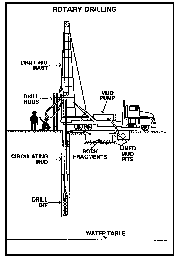
There are more than 15 million homes in America with their own water wells. More than half of the nation's drinking water is from municipal and private wells. Some estimates are that 6,000 new wells are completed each week in the United States. Virtually all these wells are drilled wells. Few people give any thought to how you make a deep vertical hole in sand or in solid rock, how the drilled pieces of rock are removed from deep below the surface, or how drillers stop the hole from collapsing before the casing (liner) is put in.
Great skill is needed to guide and control a water well drill as it penetrates sand, gravel, clay and solid rock formations deep underground. The drill rods can weigh several tons. If the drill pushes too hard or turns too fast, the drill bit will wear out; if it does not push hard enough, it won't penetrate the rocks. There often are several rock layers in a single well; each may need different drilling pressures. Once water is encountered, the driller will need to keep a close watch on the drilling process. By comparison, dentists have only one material to drill, a light can be shined to the bottom of the hole, pieces can easily be washed out and the dentist works in an air-conditioned room.
For ground water monitoring or for scientific research purposes, wells can be drilled in a way that allows the specialists to examine closely the rock formations and take frequent water samples. Augured wells and diamond core drilling are drilling techniques often used for scientific purposes. Three methods typically used for drilling water wells are rotary, air hammer and cable tool. There are other methods and combinations of methods, but these are the most common. Most home wells are drilled to 6 or 8 inches in diameter. Municipal or irrigation wells are likely to be drilled at larger diameters, sometimes as much as 24 inches or more.
In rotary drilling, a drill bit is attached to a length of connected drill pipe. The drill bit will be made of tough metals such as tungsten, and as the drill is rotated, the bit acts to grind up the rock. The broken pieces (cuttings) are flushed upward and out of the hole by circulating a drilling fluid (sometimes called drilling mud) down through the drill pipe and back to the surface. This drilling fluid also serves to cool and lubricate the drill bit, and by stabilizing the wall of the hole, it can prevent possible cave-in of unstable sands or crumbly rock before the well casing or well screen is installed. As the drill intersects water bearing rock formations, water will flow into the hole. Drillers monitor the depth of water "strikes" and note the formations in which they occur.
In areas of hard rocks, many drillers prefer to use a well drilling technique that uses compressed air to operate a down-hole air hammer on the end of the drill string that helps to break up the hard rocks. The compressed air also blows the crushed rock fragments out of the hole to the surface along with any water that flows in the well during drilling.
Another drilling technique uses a "pounder" machine, usually referred to as cable tool drilling. With this method, a heavy bit is attached to the end of a wire cable and is raised and dropped repeatedly, pounding its way downward. Periodically, cuttings are bailed out of the hole. The method is slow and, in most places, has been replaced by rotary drilling. However, the cable tool method is responsible for millions of successful wells worldwide.
In low-yielding wells, it sometimes is possible to increase yield by using hydrofrac techniques. In this process, selected parts of the drilled hole are subjected to great pressure using special tools lowered from the surface. The expected result is that small existing fractures will be enlarged or opened up to allow the well to connect to additional water-bearing fractures or fissures.
No matter which method of drilling is used, the top part of the well is usually lined with steel or plastic well casing. The diameter of the drilled hole is usually an inch or two wider than the diameter of the casing. The space between the drilled hole and the casing (the annulus) has to be filled to prevent the chance of polluted surface water migrating downward along the outside of the casing where it might contaminate the aquifer. This filling is called "grout" and (depending on local regulations) it may be either cement or special volcanic clay called bentonite. Sometimes most of the space is filled with the fine rock pieces from drilling and then the top 20 feet is grouted.
A modern water well is much more than simply a hole in the ground.
Report Abusive Comment